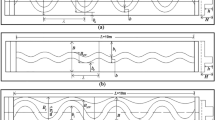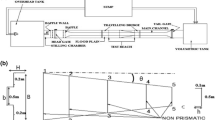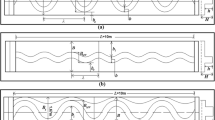Abstract
The geometric dimensions and bank profile shape of channels with boundaries containing particles on the verge of motion (threshold channels) are significant factors in channel design. In this study, extensive experimental work was done at different flow velocities to propose a reliable method capable of estimating stable channel bank profile. The proposed method is based on gene expression programming (GEP). Laboratorial datasets obtained from Mikhailova et al. (Hydro Tech Constr 14:714–722, 1980), Ikeda (J Hydraul Div ASCE 107:389–406 1981), Diplas (J Hydraul Eng ASCE 116:707–728, 1990) and Hassanzadeh et al. (J Civil Environ Eng 43(4):59–68, 2014) were used to train, test, validate and examine the GEP model in various geometric and hydraulic conditions. The obtained results demonstrate that the proposed model can estimate bank profile characteristics with great accuracy (determination coefficient of 0.973 and mean absolute relative error of 0.147). Moreover, for practical calculations of channel dimensions, the model provides a specific mathematical relationship to solve problems with different discharge rates (Q) and particles with various median grain sizes (D50). The proposed model’s performance is compared with 8 relationships suggested previously by researchers (based on empirical and theoretical analyses) and a relationship obtained using a nonlinear regression model with different experimental data. The polynomial VDM and two exponential functions, i.e. IKM and DIM, are introduced as the superior existing models. According to the present study results, the proposed GEP model can predict the bank profile shape trend well and similar to the experimental datasets. Sensitivity analysis was also applied to assess the impact of each input variable (x, Q and D50) on the presented relationship. According to the current study, the GEP model provides a suitable equation for predicting the bank profile shape of stable channels.











Similar content being viewed by others
Explore related subjects
Discover the latest articles, news and stories from top researchers in related subjects.References
Alavi AH, Gandomi AH, Nejad HC, Mollahasani A, Rashed A (2013) Design equations for prediction of pressure meter soil deformation moduli utilizing expression programming systems. Neural Comput Appl 23:1771–1786
Azamathulla HMd, Ahmad Z (2012) Gene-expression programming for transverse mixing coefficient. J Hydrol 434–435:142–148
Babaeyan-Koopaei K, Valentine EM (1998) Bank profiles of self-formed straight stable channels. In: Proceeding of the third international conference on hydroscience and engineering, Cottbus/Berlin, Germany, August 31/September 3
Cao S, Knight DW (1998) Design for hydraulic geometry of alluvial channels. J Hydraul Eng ASCE 124:484–492
Dey S (2001) Bank profile of threshold channels: a simplified approach. J Irrig Drain Eng 127:184–187
Diplas P (1990) Characteristics of self-formed straight channels. J Hydraul Eng ASCE 116:707–728
Diplas P, Vigilar G (1992) Hydraulic geometry of threshold channels. J Hydraul Eng ASCE 118:597–614
Dursun OF, Kaya N, Firat M (2012) Estimating discharge coefficient of semi-elliptical side weirs using ANFIS. J Hydrol 426:55–62
Ebtehaj I, Bonakdari H, Zaji AH, Azimi H, Sharifi A (2015) Gene expression programming to predict the discharge coefficient in rectangular side weirs. Appl Soft Comput 35:618–628
Ebtehaj I, Bonakdari H (2017) No-deposition sediment transport in sewers using gene expression programming. J Soft Comput Civil Eng 1:26–50
Ferreira C (2001) Gene expression programming: a new adaptive algorithm for solving problems. Complex Syst 13:87–129
Ferreira C (2002) Gene expression programming in problem solving. Soft computing and industry. Springer, London, pp 635–653
Ferreira C (2006) Gene expression programming: mathematical modeling by an artificial intelligence, vol 21. Springer, Berlin, p 478
Gandomi AH, Roke DA (2013) Intelligent formulation of structural engineering systems. In: Seventh M.I.T. conference on computational fluid and solid mechanics-focus: multiphysics and multiscale. Massachusetts Institute of Technology, Cambridge
Gandomi AH, Tabatabaei SM, Moradian MH, Radfar A, Alavi AH (2011) A new prediction model for the load capacity of castellated steel beams. J Constr Steel Res 67(7):1096–1105
Gharagheizi F, Ilani-Kashkouli P, Farahani N, Mohammadi AH (2012) Gene expression programming strategy for estimation of flash point temperature of non-electrolyte organic compounds. Fluid Phase Equil 329:71–77
Ghani AA, Azamathulla HMD (2011) Gene expression programming for sediment transport in sewer pipe systems. J Pipeline Syst Eng Pract 2:102–106
Ghani AA, Azamathulla HM (2014) Development of GEP-based functional relationship for sediment transport in tropical rivers. Neural Comput Appl 24(2):271–276
Gholami A, Bonakdari H, Zaji AH, Akhtari AA (2015) Simulation of open channel bend characteristics using computational fluid dynamics and artificial neural networks. Eng Appl Comput Fluid Mech 9:355–361
Gholami A, Bonakdari H, Zaji AH, Akhtari AA, Khodashenas SR (2015) Predicting the velocity field in a 90° open channel bend using a gene expression programming model. Flow Meas Instrum 46:189–192
Gholami A, Bonakdari H, Zaji AH, Ajeel Fenjan S, Akhtari AA (2016) Design of modified structure multi-layer perceptron networks based on decision trees for the prediction of flow parameters in 90° open-channel bends. Eng Appl Comput Fluid Mech 10:194–209
Gholami A, Bonakdari H, Zaji AH, Michelson DG, Akhtari AA (2016) Improving the performance of multi-layer perceptron and radial basis function models with a decision tree model to predict flow variables in a sharp 90 bend. Appl Soft Comput 48:563–583
Gholami A, Bonakdari H, Zaji AH, Fenjan SA, Akhtari AA (2017) New radial basis function network method based on decision trees to predict flow variables in a curved channel. Neural Comput Appl. https://doi.org/10.1007/s00521-017-2875-1
Gholami A, Bonakdari H, Ebtehaj I, Akhtari AA (2017) Design of an adaptive neuro-fuzzy computing technique for predicting flow variables in a 90° sharp bend. J Hydroinf 19:572
Gholami A, Bonakdari H, Ebtehaj I, Shaghaghi S, Khoshbin F (2017) Developing an expert group method of data handling system for predicting the geometry of a stable channel with a gravel bed. Earth Surf Proc Land 42(10):1460–1471
Glover RE, Florey QL (1951) Stable channel profiles. Lab. Rep. 325 Hydraul, U.S. Bureau of Reclamation, Washington
Guven A, Gunal M (2008) Genetic programming approach for prediction of local scour downstream of hydraulic structures. J Irrig Drain Eng 134:241–249
Hashmi MZ, Shamseldin AY, Melville BW (2011) Statistical downscaling of watershed precipitation using gene expression programming (GEP). Environ Model Softw 26(12):1639–1646
Hassanzadeh Y, Tabatabai MR, Imanshoar F, Jafari A (2014) Validation of river bank profiles in Sand-Bed Rivers. J Civil Environ Eng 43(4):59–68
Ikeda S (1981) Self-formed straight channels in sandy beds. J Hydraul Div ASCE 107:389–406
Ikeda S, Parker G, Kimura Y (1988) Stable width and depth of straight gravel rivers with heterogeneous bed materials. Water Resour Res 24:713–722
Khadangi E, Madvar HR, Kiani H (2009) Application of artificial neural networks in establishing regime channel relationships. In: 2nd international conference on computer, control and communication, IEEE, Carachi, Feb 17–18
Khodashenas SR (2016) Threshold gravel channels bank profile: a comparison among 13 models. Int J River Basin Manag 14(3):337–344
Khoshbin F, Bonakdari H, Ashraf Talesh SH, Ebtehaj I, Zaji AH, Azimi H (2015) ANFIS multi-objective optimization using genetic algorithm and SVD to modeling of discharge coefficient in rectangular sharp-crested side weirs. Eng Optim 48:1–16
Kisi O, Shiri J (2012) River suspended sediment estimation by climatic variables implication: comparative study among soft computing techniques. Comput Geosci 43:73–82
Koza JR (1992) Genetic programming: on the programming of computers by means of natural selection. MIT Press, Cambridge
Macky GH (1999) Large flume experiments on the stable straight gravel bed channel. Water Resour Res 35:2601–2603
Macky GH (2010) Diffusion of bed load and the development of stable straight gravel bed channels. In: 17th congress of the Asia and Pacific division of the international association of hydraulic engineering and research, APD, Auckland University, New Zealand, 241–246, Feb 2010
Madvar HR, Ayyoubzadeh SA, Atani MGH (2011) Developing an expert system for predicting alluvial channel geometry using ANN. Expert Syst Appl 38:215–222
Mikhailova NA, Shevchenko OB, Selyametov MM (1980) Laboratory of Investigation of the formation of stable channels. Hydro Tech Constr 14:714–722
Mironenko AP, Willardson LS, Jenab SA (1984) Parabolic canal design and analysis. J Irrig Drain Eng ASCE 110:241–246
Mohammadpour R, Ghani AA, Azamathulla HMD (2013) Estimation of dimension and time variation of local scour at short abutment. Int J River Basin Manag 11:121–135
Mousavi SM, Aminian P, Gandomi AH, Alavi AH, Bolandi H (2012) A new predictive model for compressive strength of HPC using gene expression programming. Adv Eng Softw 45(1):105–114
Mousavi SM, Mostafavi ES, Hosseinpour F (2014) Gene expression programming as a basis for new generation of electricity demand prediction models. Comput Ind Eng 74:120–128
Najafzadeh M, Barani GhA, Kermani MRH (2013) GMDH network based back propagation algorithm to predict abutment scour in cohesive soils. Ocean Eng 59:100–106
Onen F (2014) GEP prediction of scour around a side weir in curved channel. J Environ Eng Landsc Manag 22:161–170
Parker G (1978) Self-formed straight rivers with equilibrium banks and mobile bed: Part 2: the gravel river. J Fluid Mech 89:127–146
Pitlick J, Marr J, Pizzuto JE (2013) Width adjustment in experimental gravel-bed channels in response to overbank flows. J Geophys Res 118:553–570
Pizzuto JE (1990) Numerical simulation of gravel river widening. Water Resour Res 26:1971–1980
Rezaei H, Rahmati M, Modarress H (2017) Application of ANFIS and MLR models for prediction of methane adsorption on X and Y faujasite zeolites: effect of cations substitution. Neural Comput Appl 28(2):301–312
Shaghaghi S, Bonakdari H, Gholami A, Ebtehaj I, Zeinolabedini M (2017) Comparative analysis of GMDH neural network based on genetic algorithm and particle swarm optimization in stable channel design. Appl Math Comput 313:271–286
Stebbings J (1963) The shape of self-formed model alluvial channels. In: ICE Proceedings, vol 25, pp 485–510, Thomas Telford. http://dx.doi.org/10.1680/iicep.1963.10544
Taher-Shamsi A, Tabatabai MRM, Shirkhani R (2013) An evaluation model of artificial neural network to predict stable width in gravel bed rivers. Int J Environ Sci Technol 9:333–342
Van-Rijn LC (1984) Sediment transport, Part 1: bed load transport. J Hydraul Eng ASCE 110:1431–1456
Vigilar G, Diplas P (1997) Stable channels with mobile bed: formulation and numerical solution. J Hydraul Eng ASCE 123:189–199
Vigilar G, Diplas P (1998) Stable channels with mobile bed: model verification and graphical solution. J Hydraul Eng ASCE 124:1097–1106
Yu G, Knight DW (1998) Geometry of self-formed straight threshold channels in uniform material. Proc Inst Civil Eng Water Marit Energy 130:31–41
Zakaria NA, Azamathulla HMD, Chang CK, Ghani AA (2010) Gene-expression programming for total bed material load estimation—a case study. Sci Total Environ 408:5078–5085
Zhang Y, Pu Y, Zhang H, Su Y, Zhang L, Zhou J (2013) Using gene expression programming to infer gene regulatory networks from time-series data. Comput Biol Chem 47:198–206
Author information
Authors and Affiliations
Corresponding author
Ethics declarations
Conflict of interest
The authors declare no conflict of interest.
Rights and permissions
About this article
Cite this article
Gholami, A., Bonakdari, H., Zeynoddin, M. et al. Reliable method of determining stable threshold channel shape using experimental and gene expression programming techniques. Neural Comput & Applic 31, 5799–5817 (2019). https://doi.org/10.1007/s00521-018-3411-7
Received:
Accepted:
Published:
Issue Date:
DOI: https://doi.org/10.1007/s00521-018-3411-7




